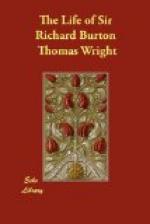Burton’s Third Volume [FN#563] consists of the tales in Galland’s edition which are not in the Nights proper. All of them, with the exception of “Alaeddin” and “Zayn Al Asnam,” are reproductions, as we said, from a Hindustani translation of the French text—the Arabic originals of the tales being still (1905) undiscovered.
His Fourth and Fifth Volumes [FN#564] are from the Wortley-Montague Text. His sixth and last [FN#565] contains the Chavis and Cazotte Text—the manuscript of which is reputed to have been brought to France by a Syrian priest named Shawish (Frenchlifted into Chavis), who collaborated with a French litterateur named Cazotte. The work appeared in 1788. “These tales,” says Mr. Payne, “seem to me very inferior, in style, conduct, and diction, to those of ’the old Arabian Nights,’ whilst I think ‘Chavis and Cazotte’s continuation’ utterly unworthy of republication whether in part or ’in its entirety.’ It is evident that Shawish (who was an adventurer of more than doubtful character) must in many instances have utterly misled his French coadjutor (who had no knowledge of Arabic), as to the meaning of the original.”—Preface to Alaeddin, &c., xv., note. Mr. Payne adds, “I confess I think the tales, even in the original Arabic, little better than rubbish, and am indeed inclined to believe they must have been, at least in part, manufactured by Shawish."[FN#566]
157. Comparison.
Burton’s supplementary volume containing “Alaeddin” and “Zayn Al Asnam,” appeared, as we have seen, in 1887; and in 1889 Mr. Payne issued a Translation from Zotenberg’s text. When dealing with the Nights proper we gave the reader an opportunity of comparing Burton’s translation with Payne’s which preceded it. We now purpose placing in juxtaposition two passages from their supplemental volumes, and we cannot do better than choose from either “Alaeddin” or “Zayn Al Asnam,” as in the case of both the order is reversed, Burton’s translation having preceded Payne’s. Let us decide on the latter. Any passage would do, but we will take that describing the finding of the ninth image:




